“Everything a person thinks and wishes for, we live in a time when a man’s own mind is wide open to anyone with the right machine. Despite this universally known fact, there’s still plenty of people wanting to deceive or hurt other humans. Now does that sound reasonable to you?”
Hi there, my name is Lilian Min and I’m going to be your Newbie Recapper for Psycho-Pass, the 2012 anime whose fan work crowded my Tumblr feed around the same time. I’ll be writing up both seasons, and maybe the movie, for The Mary Sue.
I was a huuuuge anime nerd back in that mid-2000s Shounen Jump heyday; Naruto, Bleach, Katekyo Hitman Reborn, the like. I dabbled a bit in shoujo and slice of life stuff (CLAMP stuff, Honey & Clover, Fruits Basket, Ouran High School Host Club) and weird cult faves (The Melancholy of Suzumiya Haruhi, Tengen Toppa Gurren Lagann, even fucking Hetalia), but always ended up coming back to a certain segment of philosophical sci-fi/fantasy like Eureka Seven, Neon Genesis Evangelion, Fullmetal Alchemist (my favorite anime ever), and of course, Cowboy Bebop. However, I fell out of that for a long time; it’s only recently that I’ve reclaimed that side of myself, thanks to a combination of Digimon/Attack on Titan/Homestuck. (I know.) So without ado, let’s get to it.
One of my favorite parts about anime is the intro animation and song choice; alas, that doesn’t make an appearance yet, but we’re instead introduced to a world that looks and feels like the dark, gloomy technocities of Ghost in the Shell, Akira, Darker Than Black, Blade Runner, etc. They even had ubiquitous automatons like the Tachikoma, although these look more like sentient Segways.
But the action doesn’t begin to take place in the cityscape; rather, in an elaborate digital window penthouse/cage (a villain’s lair if I’ve ever seen one), a tall, lanky, black-haired, scowling man (aka the death of everybody in the fanbase, probably) fights what looks like The Wicked + the Divine’s Woden. Looking down from a long red staircase is another tall, lanky man, though this one’s smiling, and his white hair is cut into a demented jellyfish shape.
After sending not!Woden to his really detailed gory death (the intestines…), the two men direct their attention to each other, and that’s when it’s revealed that this is all a flashback, via an off-screen female voice. The black-haired man is Shinya Kogami; the white-haired man is Shogo Makishima. They’re an immediate and obvious yin and yang, but since this is an episode one flash forward, after setting up their destiny and rivalry…
…the action immediately cuts to the “present” timeline. Who are these men? What are they to each other? Will it possible to judge this relationship outside of the obvious Spike/Vicious parallel? Moving on.
The only way to make an already bleak setting even more bleak is to add more rain, and so it is here. The ominously-sounding “Public Safety Bureau” is on the case at a scene, and we’re introduced to what is presumably our fresh-faced heroine: Akane Tsunemori, a painfully naïve rookie on the force.
(Little baby lamb.)
Paired up with the no-nonsense-looking Inspector Ginoza (you can tell he’s serious because of his thin face and the glasses), Akane’s first case is of course going to be terrible and life-changing. But before moving into the details of the case, we learn a few things about the world Psycho-Pass is set in:
In this technofuture, all people are plugged into a centralized digital control. The titular Psycho-Pass is essentially a continuous mental evaluation, which codes people according to their potential instability break levels (which are coded as “crime coefficients”). Those crime coefficients are determined by a system named (naturally) Sibyl, which like Neon Genesis Evangelion’s MAGI, taps into the information available in this world and judges individuals’ threat levels in society. I’ve never watched Minority Report, but that trope is prevalent there and in other future dystopia universes — the Big Brother idea taken to an omnipresent police state nightmare.
For Akane’s first case, a man was flagged down at a traffic stop for having a forest green Psycho-Pass, and after taking a hostage, he’s on the run. Akane and Ginoza are to neutralize the threat, but before that, we have to witness the most unintentionally hilarious subtitle translation ever:
(Bless whoever did the show’s official Netflix subtitles.)
In this wagon are four new characters: an unsmiling woman, a flirty orange-haired man, and Kogami, the black-haired man from the episode’s opening. They’re introduced as Enforcers: people whose crime coefficients mark them as latent threats to society, but who’ve instead taken up work as subservient manpower for dangerous cases. Ginoza instructs Akane to treat the Enforcers like dogs; she promptly bows and politely introduces herself to them.
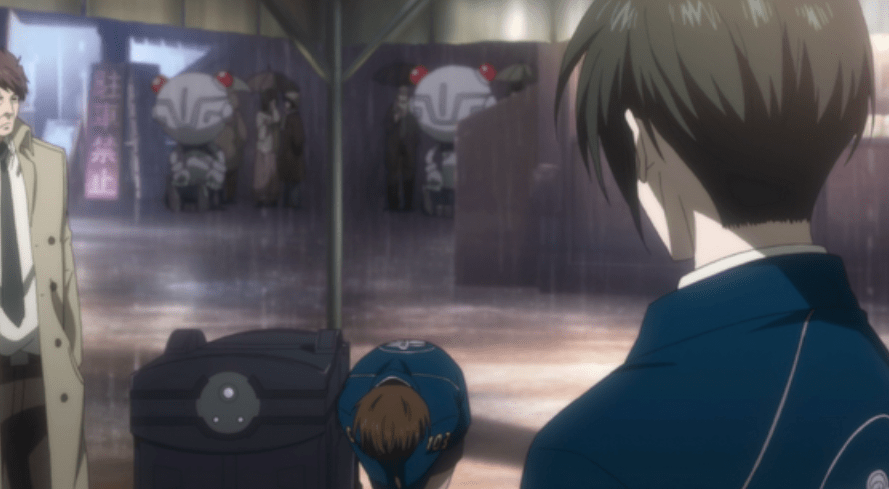 (The show’s bleak, but the comedy beats are welcome.)
(The show’s bleak, but the comedy beats are welcome.)
After Kunizuka and Kagari (the girl and the flirt) set off with Ginoza, Akane’s left with a super serious Kogami and his older, jokier counterpart, Tomomi Masaoka. It’s Masaoka who walks Akane through her main gear: A giant mind-reading gun named the Dominator. Despite its size, Masaoka explains that its default mode is Paralyzer, and that while its main use is on suspects, because of his and the other Enforcers’ latent crime coefficients, it can also be used on them if they disobey Akane’s orders. The three then set off in pursuit.
The show then switches focus to the suspect in question, a sweaty man whose bug-eyed animation is only matched by his unfortunate hostage victim’s. While his justification to taking his hostage and being on the run read a little bit like an MRA defending his hatred of feminists (“I do everything right and they just mock me!”), unlike that sad faction of society, he has a point in the reasoning and manner he was marked out for crime. In this world, once you’ve had your Psycho-Pass flagged and are subsequently branded as a potential criminal, privileges like employment and marriage are denied and normal life is presumably unachievable after. He didn’t actually do anything wrong — but in being prematurely branded a criminal, he’s come into a self-fulfilling prophecy, and attempts to rape his hostage.
As this is happening, Akane, Ginoza, and their “hounds” (nickname for Enforcers) prowl the area, and we get to learn a little bit more about old man Masaoka. He’s a gentle, guiding figure for rookie Akane, though with his robot hand and high resting crime coefficient, he clearly has history. Akane, the top of the class student (of course), receives fair warning that what she learned in the classroom won’t apply to the streets.
When Kagari (the orange-haired flirt) finds the suspect, he’s given the order to shoot to paralyze, but his Dominator gun doesn’t faze the suspect; the reasoning that he’s on stimulants or another drug is given. (Drug and vice references are dropped several times before this, suggesting that it’s a serious problem in the Psycho-Pass universe.) Sibyl then reassess the suspect’s threat (via, cleverly, a message called an Oracle), and then the big gun turns into an even bigger gun in its Lethal Eliminator mode; the suspect is so far gone, deems Sibyl, that there is no chance of rehabilitation.
It’s then that Masaoka reveals yet another piece of information to Akane: that not just the suspect, but the hostage, need to be watched and appraised as threats. In this world, people are so happy and content (read: careful and watched) that any violent trauma can then irreparably damage their psyches and thus their crime coefficients, in an effect deemed Psycho-Hazard. This is apparently contagious, and just as Masaoka’s about to reveal how that plays into becoming an Enforcer, the suspect is found, guaranteeing that the road to forced police work is full of revealing stories.
Masaoka and Akane corner the suspect, but it’s the stoic Kogami who takes the hostage out; the body horror imagery is ripe in effect as the shot rips the suspect from the inside out, creating Tetsuo-esque bulging and squirming before showering down a bloody rain. The hostage is naturally freaked out by this, and her crime coefficient spikes; Akane gets Masaoka to stand down, explaining that she can bring the hostage down to normal levels. In that time, said hostage flees, and Kogami follows in pursuit.
In the bowels of some abandoned warehouse, the hostage falls into some gasoline canisters, and with eyes wide and trembling in terror, she stares down the impassive Kogami, whose Dominator is primed to take her out much as it’d taken out her captor. But right before that happens, Akane and Masaoka appear, and desperate to save the hostage from capture, Akane makes the choice: To hit Kogami with a paralyzing shot.
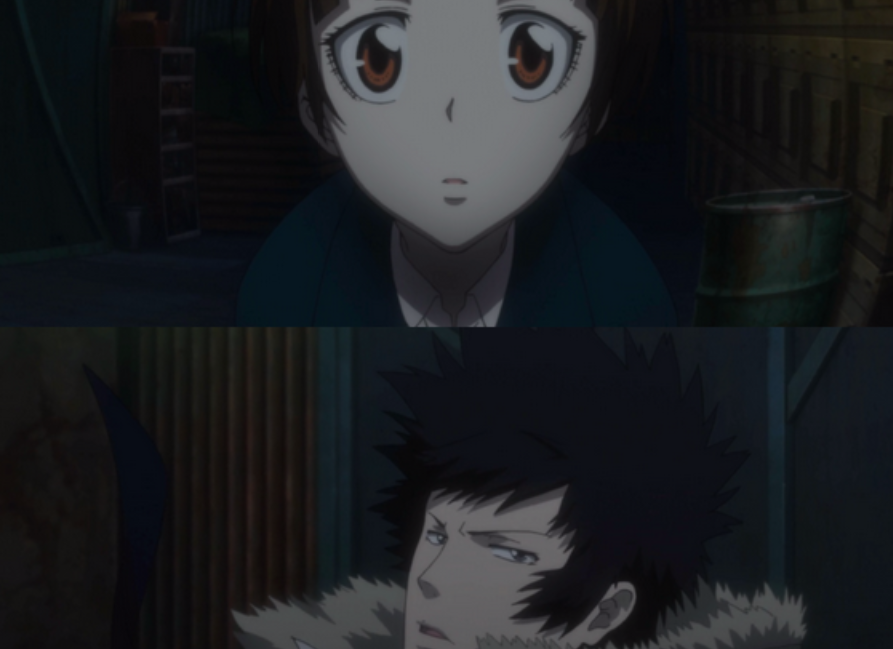 (This relationship is about to get very interesting.)
(This relationship is about to get very interesting.)
With Mr. By-the-Books out of the way, Akane gets the hostage to 1) put down her lighter, which would’ve exploded the gasoline around her and presumably the rest of the building, and 2) stabilize enough that her crime coefficient goes down to a comfortable, but still high, resting rate.
Just as Akane’s ready to celebrate her slight victory, Ginoza shoots the hostage with the Paralyzer, and both I and Akane felt a certain shock. This woman, who hadn’t done anything, was being punished for the crimes of her attacker and kidnapper; now, she was the one facing the reality that he’d literally ran to escape. The circle completes itself, and though the Enforcers and her fellow officers have no qualms
(This relationship is about to get very interesting.)
With Mr. By-the-Books out of the way, Akane gets the hostage to 1) put down her lighter, which would’ve exploded the gasoline around her and presumably the rest of the building, and 2) stabilize enough that her crime coefficient goes down to a comfortable, but still high, resting rate.
Just as Akane’s ready to celebrate her slight victory, Ginoza shoots the hostage with the Paralyzer, and both I and Akane felt a certain shock. This woman, who hadn’t done anything, was being punished for the crimes of her attacker and kidnapper; now, she was the one facing the reality that he’d literally ran to escape. The circle completes itself, and though the Enforcers and her fellow officers have no qualms about what they did, the viewer and Akane both know that something’s up, if a system that’s supposed to protect all can’t back its choices up and ensnares others in its wake.
Psycho-Pass is already showing a really strong, well-built understanding of both mental health and how it is both malleable and unpredictable, and given Akane’s reaction to her first case, things are only going to get more interesting and morally questionable from here. How does this tie in with the opening scene? Will there be any more flash forwards? Guess we’ll have to tune into episode two to find out.
Tweet your thoughts on Season 1, Episode 1 of Psycho-Pass to me here. This should go without saying, but NO SPOILERS PLEASE!
Lilian Min is a contributing editor at HelloGiggles and has written for The Atlantic, Nylon Magazine, BuzzFeed, and others. Read her other work here and tweet her here.
—Please make note of The Mary Sue’s general comment policy.—
Do you follow The Mary Sue on Twitter, Facebook, Tumblr, Pinterest, & Google +?



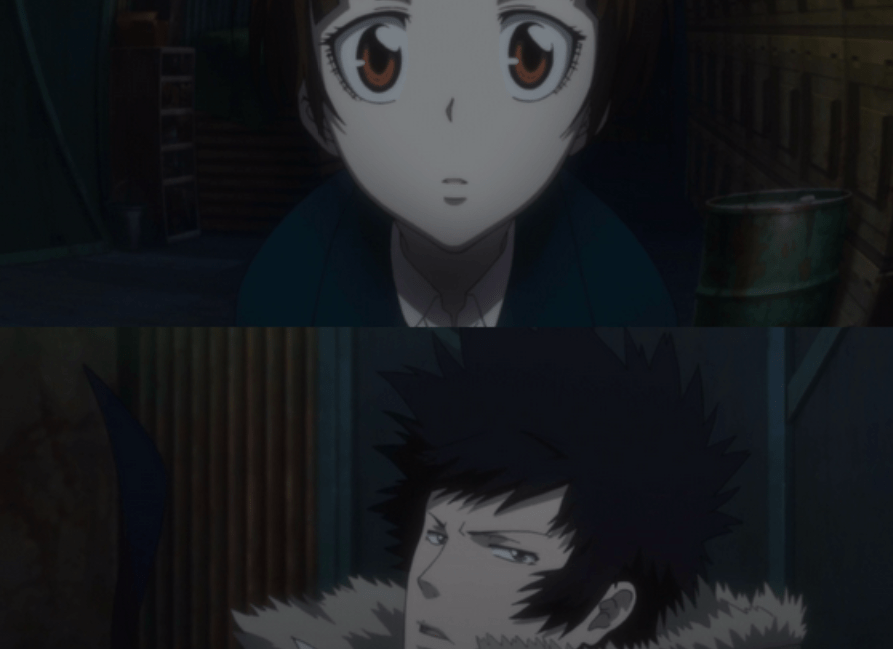
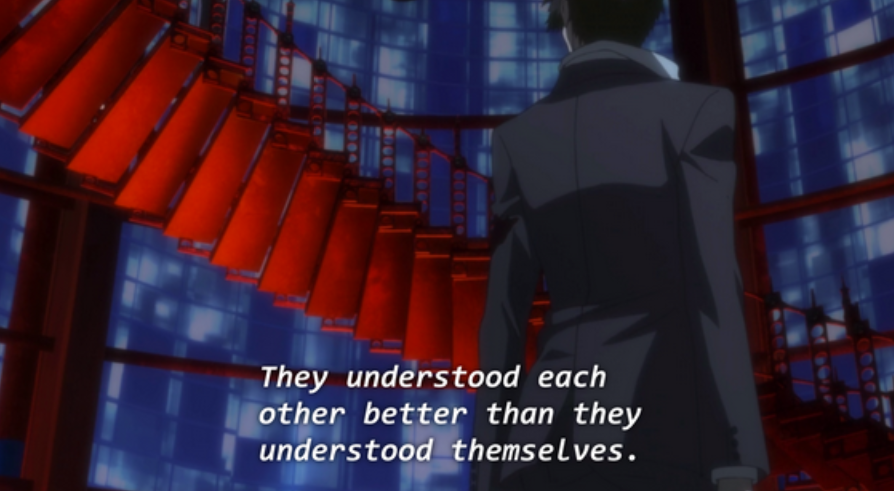
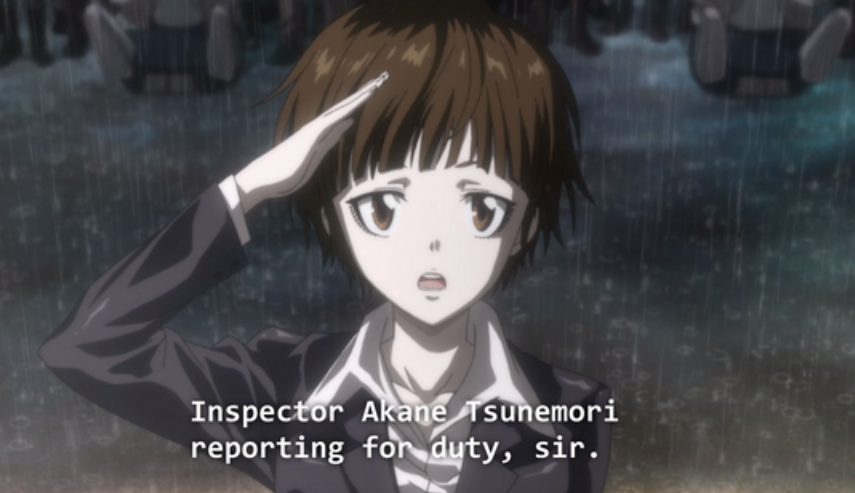





Published: Aug 16, 2015 05:00 pm